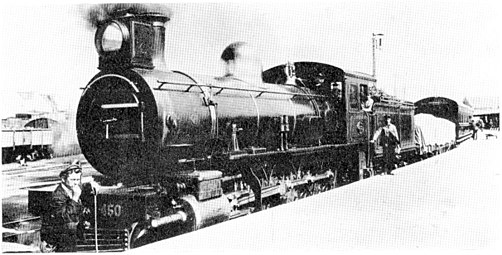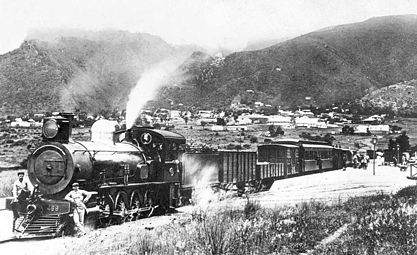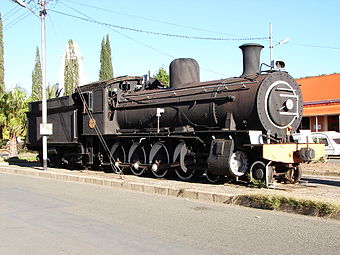South African Class 8B 4-8-0
28+1⁄2 in (724 mm)
34 in (864 mm) retyred
♥♣ 12 ft 8 in (3,861 mm)
♥ 12 LT (12,190 kg)
♣ 12 LT 11 cwt (12,750 kg)
♥♣ 12 LT 15 cwt (12,950 kg)
♣ 11 LT 18 cwt (12,090 kg)
♣ 12 LT 11 cwt (12,750 kg)
♣ 11 LT 19 cwt (12,140 kg)
♣ 11 LT 18 cwt (12,090 kg)
Bogie 2: 19 LT 8 cwt (19,710 kg)
♥ 48 LT (48,770 kg)
♣ 48 LT 6 cwt (49,080 kg)
♥ 60 LT 15 cwt (61,720 kg)
♣ 61 LT 1 cwt (62,030 kg)
♥ 98 LT 7 cwt (99,930 kg)
♣ 98 LT 13 cwt (100,200 kg)
XC, XC1, XD, XE, XE1, XF, XF1, XF2, XJ, XM, XM1, XM2, XM3 permitted
♥♣ 7 ft 1 in (2,159 mm)
♥♣ 11 ft 3⁄8 in (3,362 mm)
♥♣ 115: 2 in (51 mm)
♥♣ 18: 5+1⁄2 in (140 mm)
♥♣ 131 sq ft (12.2 m2)
♥♣ 950 sq ft (88 m2)
♥♣ 1,081 sq ft (100.4 m2)
♥ 19 in (483 mm) bore
♣ 20 in (508 mm) bore
♠♥♣ 24 in (610 mm) stroke
AAR knuckle (1930s)
| Performance figures | |
|---|---|
| Tractive effort | ♠ 23,110 lbf (102.8 kN) @ 75% ♥ 24,370 lbf (108.4 kN) @ 75% ♣ 27,000 lbf (120 kN) @ 75% |
| Career | |
|---|---|
| Operators | Central South African Railways South African Railways |
| Class | CSAR Class 8-L2 SAR Class 8B, Class 8BW |
| Number in class | 30 |
| Numbers | CSAR 441-470, SAR 1132-1161 |
| Delivered | 1903 |
| First run | 1903 |
| Withdrawn | 1972 |
The South African Railways Class 8B 4-8-0 of 1903 was a steam locomotive from the pre-Union era in Transvaal Colony.
In 1903, soon after its establishment, the Central South African Railways placed thirty Class 8-L2 4-8-0 Mastodon type steam locomotives in service. In 1912, when they were assimilated into the South African Railways, they were renumbered and designated Class 8B.[1][2][3][4]
Central South African Railways
Upon the establishment of the Central South African Railways (CSAR) in July 1902, a month after the end of the Second Boer War, Chief Locomotive Superintendent P.A. Hyde became the custodian of a mixed bag of locomotives inherited from the Imperial Military Railways (IMR). Apart from those locomotives which had been acquired new by the IMR during the war, these included engines which originated with the Selati Railway, the Nederlandsche Zuid-Afrikaansche Spoorweg-Maatschappij (NZASM), the Pretoria-Pietersburg Railway (PPR) and the Oranje-Vrijstaat Gouwerment-Spoorwegen (OVGS).[2][5]
Manufacturers
The comparatively small number of serviceable locomotives which were immediately available for service, compounded by the poor condition of many of the original NZASM, PPR, Selati and OVGS locomotives as well as an expected post-war increase in traffic, led to an order for thirty Cape 8th Class 4-8-0 steam locomotives from Neilson, Reid and Company.[1][2][6]

They were built to the specifications of the 8th Class 4-8-0 Mastodon type designed by H.M. Beatty, the Chief Locomotive Superintendent of the Cape Government Railways (CGR) from 1896 to 1910, and were the first locomotives to be ordered under the CSAR administration. Since they differed from the Class 8-L1 which had been inherited from the IMR by being equipped with Drummond tubes, these locomotives were designated CSAR Class 8-L2.[1][4]
While they were being built, Neilson, Reid amalgamated with Dübs and Company and Sharp, Stewart and Company to form the North British Locomotive Company (NBL). As a result, the first ten of these locomotives, numbered in the range from 441 to 450, were delivered as built by Neilson, Reid, while the other twenty, numbered in the range from 451 to 470, were delivered as built by NBL, even though all the NBL locomotives were also built at the Hyde Park shops of the former Neilson, Reid.[1][7]
Drummond tubes
When Hyde placed the order for these locomotives, he specified fireboxes equipped with Drummond water tubes. This involved the installation of crossing water tubes into the firebox, as featured on the London and South Western Railway's T9 Class and L11 Class, in an attempt to increase the heating surface area of the water, albeit at the cost of increased boiler complexity. The tubes were arranged in two clusters and angled to aid circulation. Visible exterior evidence of the presence of Drummond tubes was the two offset rectangular inspection covers attached to the sides of the firebox. They contained stay plugs, serving stays which extended through the tubes from cover to cover through the firebox.[1][2]
The CGR had also experimented with Drummond tubes by modifying its 6th Class no. 286 and had found that the benefit in improved performance was minimal, while the tubes were inclined to leak and were difficult to maintain. Like the CGR, the CSAR soon learned that the increase in steaming capacity was not sufficient to warrant the additional initial cost and increased maintenance requirements.[1][2]
Apart from the Drummond tubes, the locomotives differed from the Class 8-L1 in a few particulars. Their coupling rods were "H" section instead of rectangular, while their crank pins were slightly larger.[2]
South African Railways
When the Union of South Africa was established on 31 May 1910, the three Colonial government railways (CGR, Natal Government Railways and CSAR) were united under a single administration to control and administer the railways, ports and harbours of the Union. Although the South African Railways and Harbours came into existence in 1910, the actual classification and renumbering of all the rolling stock of the three constituent railways were only implemented with effect from 1 January 1912.[3][8]

In 1912, these locomotives were renumbered in the range from 1132 to 1161 and designated Class 8B on the SAR.[3][4][9]
The Class 8-L2 locomotives, together with the CSAR's Classes 8-L1 and 8-L3 4-8-0 Mastodon type locomotives and all the CGR's 8th Class 2-8-0 Consolidations and 4-8-0 Mastodons were grouped into ten different sub-classes by the SAR. The 4-8-0 locomotives became SAR Classes 8 and 8A to 8F and the 2-8-0 locomotives became Classes 8X to 8Z.[10]
Modifications
In the SAR era, the Drummond tubes were gradually removed as and when the boilers required repairs, but the locomotives retained their Class 8B designation.[1]
During A.G. Watson's term as the Chief Mechanical Engineer (CME) of the SAR from 1929 to 1936, many of the Class 8 to Class 8F locomotives were equipped with superheated boilers, larger bore cylinders and either inside or outside admission piston valves.[4][10]
The outside admission valve locomotives had their cylinder bore increased from 18+1⁄2 inches (470 millimetres) to 19 inches (483 millimetres) and retained their existing SAR classifications, while the inside admission valve locomotives had their cylinder bore increased to 20 inches (508 millimetres) and were reclassified, with a "W" suffix added to their existing SAR classifications.[4][10]
Of the Class 8B locomotives, nine were equipped with superheating, 19 inches (483 millimetres) bore cylinders and outside admission piston valves, while retaining their Class 8B classification.[10]
Six locomotives were equipped with superheating, 20 inches (508 millimetres) bore cylinders and inside admission piston valves and were reclassified to Class 8BW.[10]
Service
In SAR service, the 4-8-0 Class 8 family of locomotives served on every system in the country and, in the 1920s, became the mainstay of motive power on many branch lines. Their final days were spent in shunting service. They were all withdrawn from service by 1972.[4]
Works numbers
The Class 8B and 8BW builders, works numbers, renumbering and superheating modifications are listed in the table.[3][6][10]
Builder | Works No. | CSAR No. | SAR No. | SAR Model |
|---|---|---|---|---|
| Neilson Reid | 6351 | 441 | 1132 | Superheated |
| Neilson Reid | 6352 | 442 | 1133 | |
| Neilson Reid | 6353 | 443 | 1134 | Class 8BW |
| Neilson Reid | 6354 | 444 | 1135 | Class 8BW |
| Neilson Reid | 6355 | 445 | 1136 | Class 8BW |
| Neilson Reid | 6356 | 446 | 1137 | Superheated |
| Neilson Reid | 6357 | 447 | 1138 | |
| Neilson Reid | 6358 | 448 | 1139 | Superheated |
| Neilson Reid | 6359 | 449 | 1140 | |
| Neilson Reid | 6360 | 450 | 1141 | |
| NBL | 15783 | 451 | 1142 | Class 8BW |
| NBL | 15784 | 452 | 1143 | |
| NBL | 15785 | 453 | 1144 | Class 8BW |
| NBL | 15786 | 454 | 1145 | |
| NBL | 15787 | 455 | 1146 | Superheated |
| NBL | 15788 | 456 | 1147 | |
| NBL | 15789 | 457 | 1148 | |
| NBL | 15790 | 458 | 1149 | |
| NBL | 15791 | 459 | 1150 | |
| NBL | 15792 | 460 | 1151 | Superheated |
| NBL | 15793 | 461 | 1152 | Superheated |
| NBL | 15794 | 462 | 1153 | Class 8BW |
| NBL | 15795 | 463 | 1154 | Superheated |
| NBL | 15796 | 464 | 1155 | Superheated |
| NBL | 15797 | 465 | 1156 | |
| NBL | 15798 | 466 | 1157 | |
| NBL | 15799 | 467 | 1158 | Superheated |
| NBL | 15800 | 468 | 1159 | |
| NBL | 15801 | 469 | 1160 | |
| NBL | 15802 | 470 | 1161 |
Illustration
The main picture is a scan of a c. 1935 post card, showing a SAR Class 8B, ex CSAR Class 8-L2, banking at the Waterval Boven tunnel. The pictures below illustrate unmodified locomotives with Drummond tubes as well as superheated locomotives with outside admission piston valves (no. 1155) and inside admission piston valves (no. 1153).
-
 CSAR no. 441 works picture, with Drummond tubes, SAR no. 1132, c. 1903
CSAR no. 441 works picture, with Drummond tubes, SAR no. 1132, c. 1903 -
 CSAR no. 450 with Drummond tubes, SAR no. 1141, c. 1910
CSAR no. 450 with Drummond tubes, SAR no. 1141, c. 1910 -
 CSAR no. 466, SAR no. 1157, Barberton line, c. 1910
CSAR no. 466, SAR no. 1157, Barberton line, c. 1910 -
 CSAR no. 468 with Drummond tubes, SAR no. 1159, Barberton, c. 1910
CSAR no. 468 with Drummond tubes, SAR no. 1159, Barberton, c. 1910 - No. 1153 with inside admission piston valves, Fauresmith, 28 April 2013
-
 No. 1155 with outside admission piston valves, Kloof Station, KwaZulu-Natal, 9 February 2011
No. 1155 with outside admission piston valves, Kloof Station, KwaZulu-Natal, 9 February 2011
References

- ^ a b c d e f g Holland, D.F. (1971). Steam Locomotives of the South African Railways. Vol. 1: 1859–1910 (1st ed.). Newton Abbott, England: David & Charles. pp. 56, 127. ISBN 978-0-7153-5382-0.
- ^ a b c d e f Espitalier, T.J.; Day, W.A.J. (1945). The Locomotive in South Africa - A Brief History of Railway Development. Chapter VI - Imperial Military Railways and C.S.A.R. (Continued). South African Railways and Harbours Magazine, January 1945. pp. 11-16.
- ^ a b c d Classification of S.A.R. Engines with Renumbering Lists, issued by the Chief Mechanical Engineer's Office, Pretoria, January 1912, pp. 8, 12, 15, 41 (Reprinted in April 1987 by SATS Museum, R.3125-6/9/11-1000)
- ^ a b c d e f Paxton, Leith; Bourne, David (1985). Locomotives of the South African Railways (1st ed.). Cape Town: Struik. pp. 48–49. ISBN 0869772112.
- ^ Durrant, AE (1989). Twilight of South African Steam (1st ed.). Newton Abbott: David & Charles. p. 8. ISBN 0715386387.
- ^ a b Neilson, Reid works list, compiled by Austrian locomotive historian Bernhard Schmeiser
- ^ North British Locomotive Company works list, compiled by Austrian locomotive historian Bernhard Schmeiser
- ^ The South African Railways - Historical Survey. Editor George Hart, Publisher Bill Hart, Sponsored by Dorbyl Ltd., Published c. 1978, p. 25.
- ^ Holland, D. F. (1972). Steam Locomotives of the South African Railways. Vol. 2: 1910-1955 (1st ed.). Newton Abbott, England: David & Charles. p. 139. ISBN 978-0-7153-5427-8.
- ^ a b c d e f South African Railways and Harbours Locomotive Diagram Book, 2'0" & 3'6" Gauge Steam Locomotives, 15 August 1941, as amended
- v
- t
- e
- CSAR 0-6-0ST 1896
- CSAR 4-6-0T 1887
- CSAR Class 6-L1
- CSAR Class 6-L2
- CSAR Class 6-L3
- CSAR Class 7
- CSAR Class 8-L1
- CSAR Class 8-L2
- CSAR Class 8-L3
- CSAR Class 9
- CSAR Class 10 1904
- CSAR Class 10 1910
- CSAR Class 10-2 Saturated
- CSAR Class 10-2 Superheated
- CSAR Class 10-C
- CSAR Class 11
- CSAR Class B 0-6-4T
- CSAR Class C 2-8-4T
- CSAR Class D
- CSAR Class E 4-8-0TT
- CSAR Class E 4-8-2T
- CSAR Class E 4-10-2T
- CSAR Class F
- CSAR Class M
- CSAR Mallet Saturated
- CSAR Mallet Stoker
- CSAR Mallet Superheated
- CSAR Rack 4-6-4RT
- CSAR Railmotor
- IMR 0-6-0ST 1896
- IMR 4-6-0T 1887
- IMR 46 Tonner 0-6-4T
- IMR 55 Tonner 2-6-4T
- IMR 7th Class 4-8-0
- IMR 8th Class 4-8-0
- IMR Reid Tenwheeler 4-10-2T
- IMR Western Australian 2-8-4T
- NZASM 10 Tonner
- NZASM 13 Tonner
- NZASM 14 Tonner
- NZASM 18 Tonner
- NZASM 19 Tonner
- NZASM 32 Tonner
- NZASM 40 Tonner
- NZASM 46 Tonner
- OVGS 1st Class 4-4-0TT
- OVGS 2nd Class 2-6-0
- OVGS 2nd Class 2-6-0ST
- OVGS 3rd Class 4-4-0
- OVGS 4th Class G 4-6-0
- OVGS 5th Class K 4-6-0 1890
- OVGS 5th Class K 4-6-0 1891
- OVGS 6th Class L 4-6-0
- OVGS 6th Class L2 4-6-0
- OVGS 6th Class L3 4-6-0
- PPR 0-4-0ST Natal
- PPR 26 Tonner
- PPR 35 Tonner Portuguese
- PPR 55 Tonner
- CSAR Pankop





















